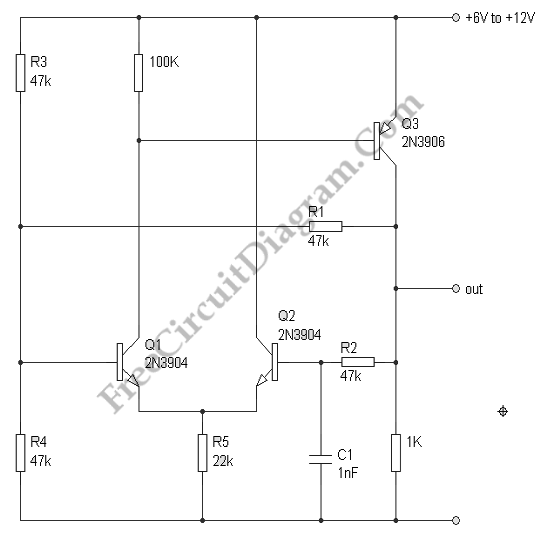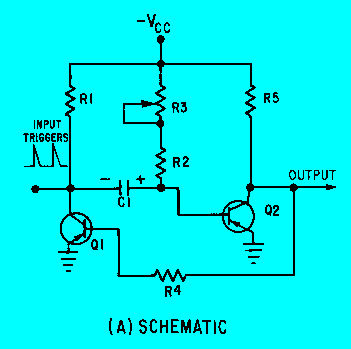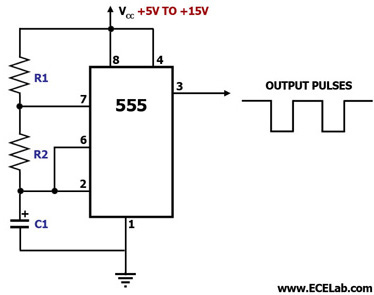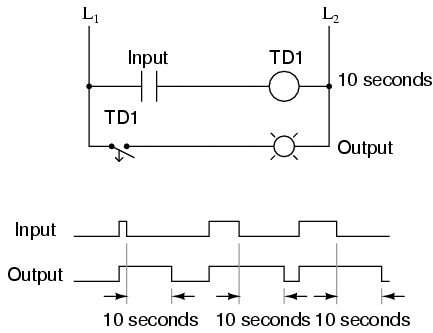
astable multivibrator
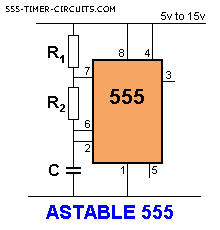
The capacitor C charges through resistors R1 and R2. When the voltage across the capacitor reaches 2/3 of the supply voltage, pin 6 detects this condition, and pin 7 is connected to ground (0V). The capacitor then discharges through resistor R2 until its voltage drops to 1/3 of the supply voltage. At this point, pin 2 detects the voltage level and turns off pin 7, initiating a repeat of the cycle. The graph scales are logarithmic; for example, 21k is approximately aligned with "1" on the 10k scale. A line drawn parallel to the graph lines will intersect the 0.1u line, yielding an approximate frequency of 900Hz. Similarly, 210k is close to the first "0" on the 100k scale, and a line drawn parallel to the graph will intersect the 1u line, resulting in an approximate frequency of 9Hz.
The described circuit operates as a relaxation oscillator, utilizing a capacitor and resistors to generate oscillations. The charging and discharging of the capacitor C through resistors R1 and R2 create a timing cycle that is crucial for the oscillator's frequency output.
In this configuration, the capacitor charges towards the supply voltage, and the voltage levels are monitored by two comparator pins (pin 6 and pin 2). The thresholds for triggering the state changes of pin 7 are set at 2/3 and 1/3 of the supply voltage, respectively. This hysteresis ensures stable operation without false triggering due to noise.
The resistors R1 and R2 play essential roles in determining the charge and discharge rates of the capacitor, directly influencing the frequency of oscillation. The logarithmic scales provided in the graph assist in visualizing the relationship between resistance values and frequency output, allowing for easier calculations and adjustments in circuit design.
The frequency can be calculated using the formula derived from the time constants associated with the charging and discharging cycles. The approximate frequencies of 900Hz and 9Hz correspond to specific resistor values (21k and 210k) and are indicative of the circuit's versatility in generating different frequencies based on component selection.
This oscillator design is commonly used in various applications, including timers, pulse generation, and tone generation in audio circuits, demonstrating its utility in electronic systems.The capacitor C charges via R1 and R2 and when the voltage on the capacitor reaches 2/3 of the supply, pin 6 detects this and pin 7 connects to 0v. The capacitor discharges through R2 until its voltage is 1/3 of the supply and pin 2 detects this and turns off pin 7 to repeat the cycle.
The scales on the graph are logarithmic so that 21k is approxi mately near the "1" on the 10k. Draw a line parallel to the lines on the graph and where it crosses the 0. 1u line, is the answer. The result is approx 900Hz. The scales on the graph are logarithmic so that 210k is approximately near the first "0" on the 100k. Draw a line parallel to the lines on the graph and where it crosses the 1u line, is the answer. The result is approx 9Hz. 🔗 External reference
The described circuit operates as a relaxation oscillator, utilizing a capacitor and resistors to generate oscillations. The charging and discharging of the capacitor C through resistors R1 and R2 create a timing cycle that is crucial for the oscillator's frequency output.
In this configuration, the capacitor charges towards the supply voltage, and the voltage levels are monitored by two comparator pins (pin 6 and pin 2). The thresholds for triggering the state changes of pin 7 are set at 2/3 and 1/3 of the supply voltage, respectively. This hysteresis ensures stable operation without false triggering due to noise.
The resistors R1 and R2 play essential roles in determining the charge and discharge rates of the capacitor, directly influencing the frequency of oscillation. The logarithmic scales provided in the graph assist in visualizing the relationship between resistance values and frequency output, allowing for easier calculations and adjustments in circuit design.
The frequency can be calculated using the formula derived from the time constants associated with the charging and discharging cycles. The approximate frequencies of 900Hz and 9Hz correspond to specific resistor values (21k and 210k) and are indicative of the circuit's versatility in generating different frequencies based on component selection.
This oscillator design is commonly used in various applications, including timers, pulse generation, and tone generation in audio circuits, demonstrating its utility in electronic systems.The capacitor C charges via R1 and R2 and when the voltage on the capacitor reaches 2/3 of the supply, pin 6 detects this and pin 7 connects to 0v. The capacitor discharges through R2 until its voltage is 1/3 of the supply and pin 2 detects this and turns off pin 7 to repeat the cycle.
The scales on the graph are logarithmic so that 21k is approxi mately near the "1" on the 10k. Draw a line parallel to the lines on the graph and where it crosses the 0. 1u line, is the answer. The result is approx 900Hz. The scales on the graph are logarithmic so that 210k is approximately near the first "0" on the 100k. Draw a line parallel to the lines on the graph and where it crosses the 1u line, is the answer. The result is approx 9Hz. 🔗 External reference
